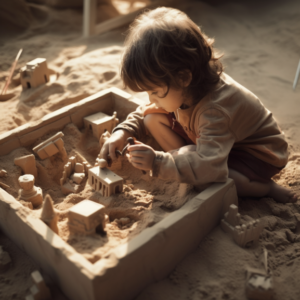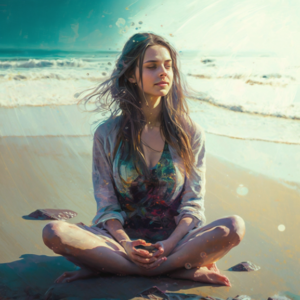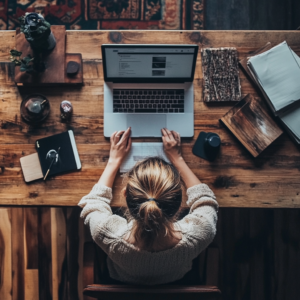Have you ever felt stuck in a rut, trying to come up with something new but just can’t seem to break through? You’re not alone. Many people struggle with unleashing their creative side.
Creativity isn’t just about painting a masterpiece or writing a hit song; it’s about thinking in new ways to solve problems and bring fresh ideas to life.
A fun fact: creativity uses both sides of your brain. Yes, that means everyone has the potential to be creative, not just the so-called ‘artsy’ types. This blog will guide you through what creativity really means, show you why it matters more than ever today, and give you tips on how to kindle that creative spark within yourself.
Get ready for some inspiration!
Key Takeaways
- Creativity sparks imagination, leading to innovation in various fields like technology and art. It involves seeing connections between unrelated things, which fosters original ideas and solutions.
- Everyone has the potential for creativity since it engages both sides of the brain. By being open to new experiences and encouraging diverse perspectives, individuals can further develop their creative abilities.
- Encouraging a creative environment is crucial in workplaces as it drives innovation and productivity. Techniques such as embracing playfulness, engaging in mindfulness practices, and fostering collaboration can enhance creativity.
- Examples of creativity in action include Steve Jobs revolutionizing the tech industry with user-friendly devices and Gaudi’s architecture inspiring awe through its uniqueness. These instances show how innovative thinking can impact industries and culture significantly.
- Artistic expressions from figures like Leonardo da Vinci or movements like hip-hop have deeply influenced societal norms and contributed to cultural identity formation, showcasing the power of creativity beyond problem-solving into shaping human experience across time.
Defining Creativity
Creativity is the spark that ignites imagination and leads to original ideas. It encompasses innovative thinking across various domains, driving individuals to seek unconventional solutions.
Understanding its essence in various domains
Creativity shows its colors across various fields, from art to technology. In art, creativity breathes life into new styles and movements. Artists like Picasso and Van Gogh broke the mold with their unique visions, changing how we see beauty.
Meanwhile, in tech, innovation drives progress. Think about how smartphones revolutionized communication. Inventors imagined a world where people could carry a computer in their pocket – and made it happen.
Creativity is seeing what everyone else has seen and thinking what no one else has thought.
The Importance of Creativity
Creativity is crucial for stimulating innovation and finding new solutions. It supports problem-solving and nurtures a culture of ingenuity. To learn more, keep reading!
Why it’s crucial for innovation and problem-solving
Innovation thrives on creativity. It’s like the secret sauce that makes problem-solving not just effective, but groundbreaking. Think about the big leaps in technology or medicine.
They didn’t come from following the same old paths. No, they stemmed from out-of-the-box thinking, where imagination and originality paved the way for new solutions. This approach has led to inventions that reshape industries and create better ways of living.
Problem-solving, on its own, tackles challenges head-on. But add creativity into the mix, and you get solutions that are as ingenious as they are unexpected. This combination is vital for facing today’s fast-paced changes and complex issues head-on.
Creative minds can see connections where others see dead ends, turning obstacles into opportunities for innovation.
Characteristics of Creative Individuals
Creative individuals possess a natural openness to new experiences and ideas. They have an innate ability to see connections between seemingly unrelated concepts, enabling them to think outside the box and generate innovative solutions.
Openness to experience
An affinity for new experiences is a notable characteristic in creative individuals. They eagerly tackle new obstacles and thrive amidst the unfamiliar. It’s as though they possess an inherent sense for adventure, always prepared to traverse unexplored regions of imagination and novelty.
These people don’t hesitate in the face of the unknown; rather, they welcome it wholeheartedly, thirsty for the knowledge that exists outside their comfort zones.
Within the sphere of creativity, a welcoming attitude towards novelty is more than a mentality; it’s a life philosophy.
Welcoming the new enables them to perceive connections that others may overlook. This capacity ignites their innovation and originality, establishing them as trailblazers in their professions.
Now let’s see how this fearless disposition assists in identifying links between apparently unrelated concepts.
Ability to see connections
Creativity is not just about coming up with original ideas but also being able to see connections between seemingly unrelated things. This ability often sets creative individuals apart, allowing them to draw inspiration from diverse sources and identify innovative solutions to complex problems.
By recognizing patterns and relationships that others may overlook, these individuals can generate unique insights and approaches that lead to groundbreaking innovations across various domains.
This skill of seeing connections extends beyond traditional problem-solving scenarios. Creative thinkers can link concepts from different fields or cultures, leading to cross-disciplinary breakthroughs and fostering a deeper understanding of the world around us.
For example, renowned inventor Leonardo da Vinci’s ability to connect his observations in art and engineering led him to develop pioneering designs for machines centuries ahead of his time, demonstrating the power of this innate capability in driving progress and ingenuity.
How Creativity Can Be Cultivated
To cultivate creativity, individuals can foster inspiration through exploring new experiences and allowing their minds to wander without limitations. They can also encourage a creative environment at work by promoting brainstorming sessions and recognizing innovative ideas.
Techniques to foster creativity in everyday life
To foster creativity in everyday life, consider the following techniques:
- Engage in Mindfulness Practices:
- Take time for meditation or deep breathing exercises to clear the mind and invite in new perspectives.
- Cultivate awareness of surroundings by focusing on sensory experiences like sight, sound, and touch.
- Embrace Diversity of Experiences:
- Explore new hobbies or activities outside your usual routine to spark fresh ideas and inspiration.
- Seek out diverse perspectives by engaging with people from different backgrounds and cultures.
- Encourage Playfulness and Experimentation:
- Approach tasks with a playful attitude, allowing room for trial and error without fear of failure.
- Use creative prompts like word associations or visual stimuli to brainstorm ideas freely.

- Maintain a Creative Environment:
- Surround yourself with stimulating artwork, vibrant colors, and natural elements to enhance the space where you work or relax.
- Keep a journal or sketchbook handy for capturing spontaneous thoughts and ideas.
- Exercise Regularly:
- Physical activity has been shown to enhance cognitive function and stimulate creative thinking.
- Consider incorporating walks, yoga, or other forms of exercise into your daily routine.
- Schedule Downtime for Reflection:
- Allow moments of quiet reflection to process experiences and generate new insights.
- Create dedicated time for daydreaming, as it can lead to innovative ideas and solutions.
- Collaborate with Others:
- Engage in collaborative projects that involve bouncing ideas off others and combining different viewpoints.
- Participate in group activities that foster teamwork and encourage collective creativity.
By incorporating these techniques into your daily life, you can cultivate an environment rich in creativity, leading to fresh perspectives and innovative solutions.
Encouraging a creative environment at work
Encouraging a creative environment at work is crucial for nurturing innovation and productivity. Here are some ways to achieve this:
- Embrace diverse perspectives: Encourage employees from varied backgrounds and experiences to contribute ideas, fostering a rich tapestry of creativity within the workplace.
- Create open communication channels: Establish a culture where employees feel comfortable sharing their innovative thoughts and suggestions without fear of judgment or ridicule.
- Provide opportunities for experimentation: Allow employees to explore new concepts and approaches, empowering them to take calculated risks in pursuit of innovative solutions.
- Support continuous learning: Offer resources for skill development and growth, nurturing an environment where creativity thrives on constant evolution.
- Foster collaboration: Encourage teamwork and cross-departmental partnerships, enabling individuals to leverage diverse skills and viewpoints in pursuit of collective creativity.
- Recognize and reward creative contributions: Acknowledge and celebrate innovative ideas, reinforcing the value of creativity within the organizational culture.
Creating a workplace that embraces creativity not only drives innovation but also cultivates a sense of fulfillment among employees, ultimately leading to greater success for the organization as a whole.
Examples of Creativity in Action
- Steve Jobs’ innovative approach revolutionized the tech industry, introducing user-friendly devices that redefined how people interact with technology.
- The mesmerizing architecture of Gaudi’s Sagrada Familia in Barcelona tells a visual story and continues to inspire awe and creativity in architectural design worldwide.
Innovations that changed industries
The assembly line, developed by Henry Ford in 1913, revolutionized the automotive industry by significantly increasing production speed and reducing costs. This innovation paved the way for mass production, transforming automobiles from luxury items into affordable commodities for everyday consumers.
Likewise, in 2007, Apple introduced the iPhone, a pioneering product that combined a phone, music player, and internet device into one compact gadget. This innovation transformed the telecommunications industry and revolutionized how people interact with technology on a daily basis.
In 1998, Google’s PageRank algorithm fundamentally changed the landscape of internet search engines by prioritizing relevant results based on page authority instead of content keywords alone.
This shift solidified Google’s dominance in online search and established them as a key player in shaping digital information retrieval. Additionally, Airbnb disrupted the hospitality industry in 2008 by providing an online platform for individuals to rent out their homes or spare rooms to travelers worldwide.
This democratization of lodging options challenged traditional hotel chains and reshaped travel accommodation norms on a global scale.
Artistic expressions that impacted culture
Transitioning from innovations that changed industries, let’s explore artistic expressions that have left a lasting impact on culture. From the Renaissance artworks of Leonardo da Vinci and Michelangelo to the vibrant beats of hip-hop music, creative endeavors have continuously shaped societal norms and attitudes.
Take for instance the iconic “Mona Lisa” painting, which not just revolutionized portrait art but also became a symbol of enigmatic beauty and mystery. Similarly, literary masterpieces like Shakespeare’s plays brought forth timeless narratives that continue to resonate with audiences worldwide.
These artistic contributions delve beyond mere entertainment; they serve as mirrors reflecting the evolution and diversity of humanity.
Creativity has woven its way through history, leaving behind a rich tapestry adorned with paintings, sculptures, literature, music, dance forms – all contributing to cultural discourse and identity formation while challenging mainstream perspectives.
Whether it’s the expressive graffiti in urban landscapes or cutting-edge fashion statements on runways, artistic expressions continually push boundaries and provide platforms for social commentary and change.
The evocative power of these creations has undeniably played a pivotal role in shaping our collective consciousness across different epochs – showcasing how creativity transcends time and connects us all through shared human experiences.
Conclusion
In wrapping up, creativity involves originality, problem-solving, and innovation across various domains. By nurturing a creative environment and implementing techniques to enhance imaginative thinking, individuals can reveal their potential for innovative solutions.
This not only ignites advancements but also influences culture and industries alike. Therefore, it’s crucial to acknowledge the practicality and efficiency of nurturing creativity in everyday life.
Embracing creativity leads to unique perspectives that challenge norms and provoke positive change. Remember, everyone has the capacity for imagination – so embrace your inner visionary and unleash your creative potential!
